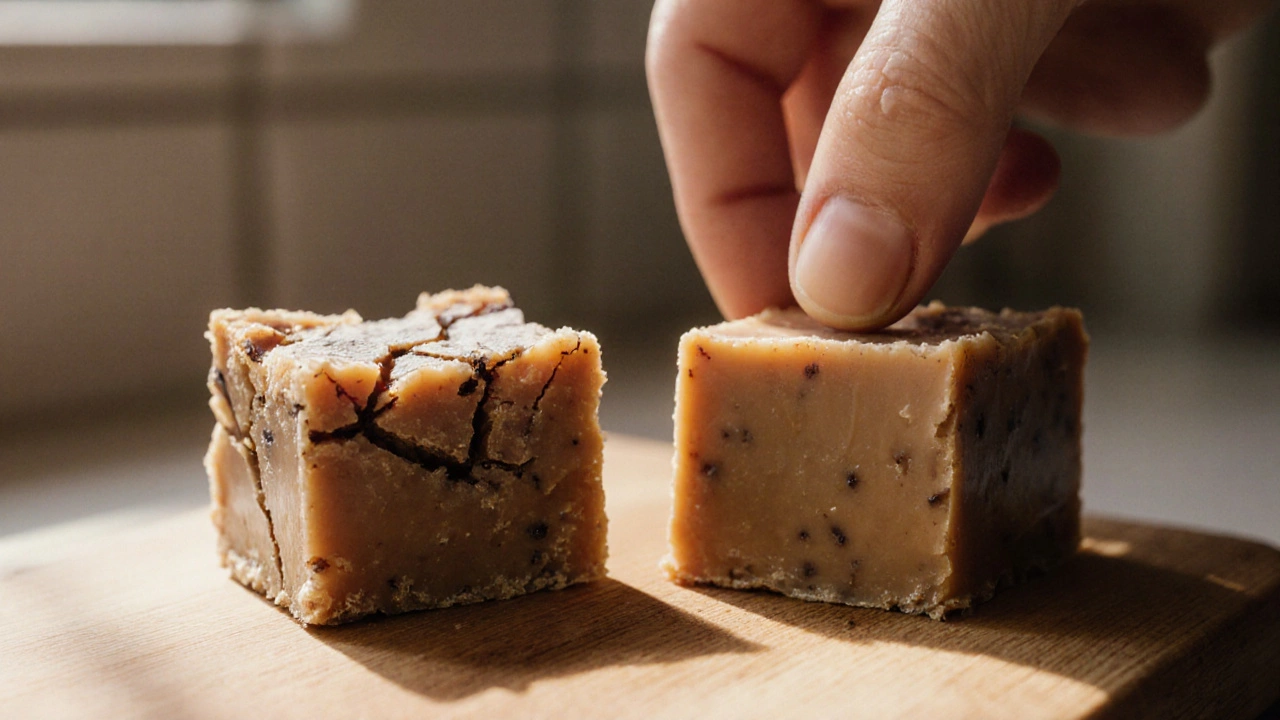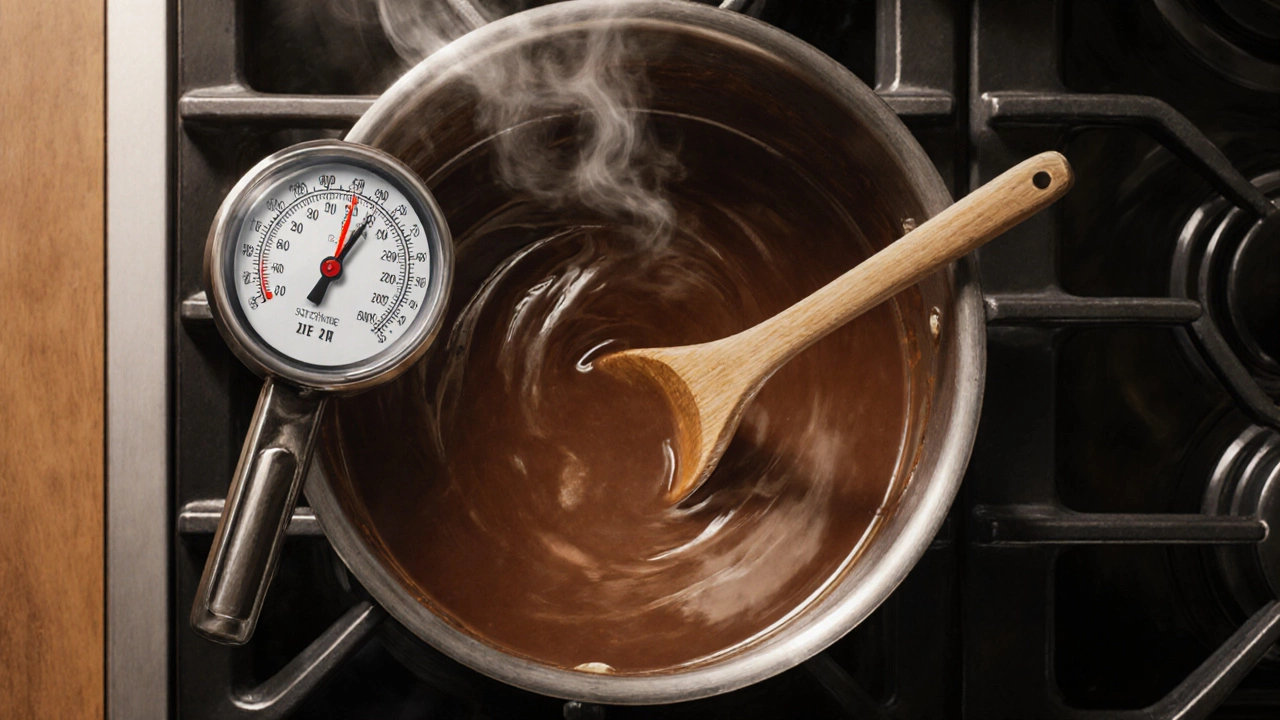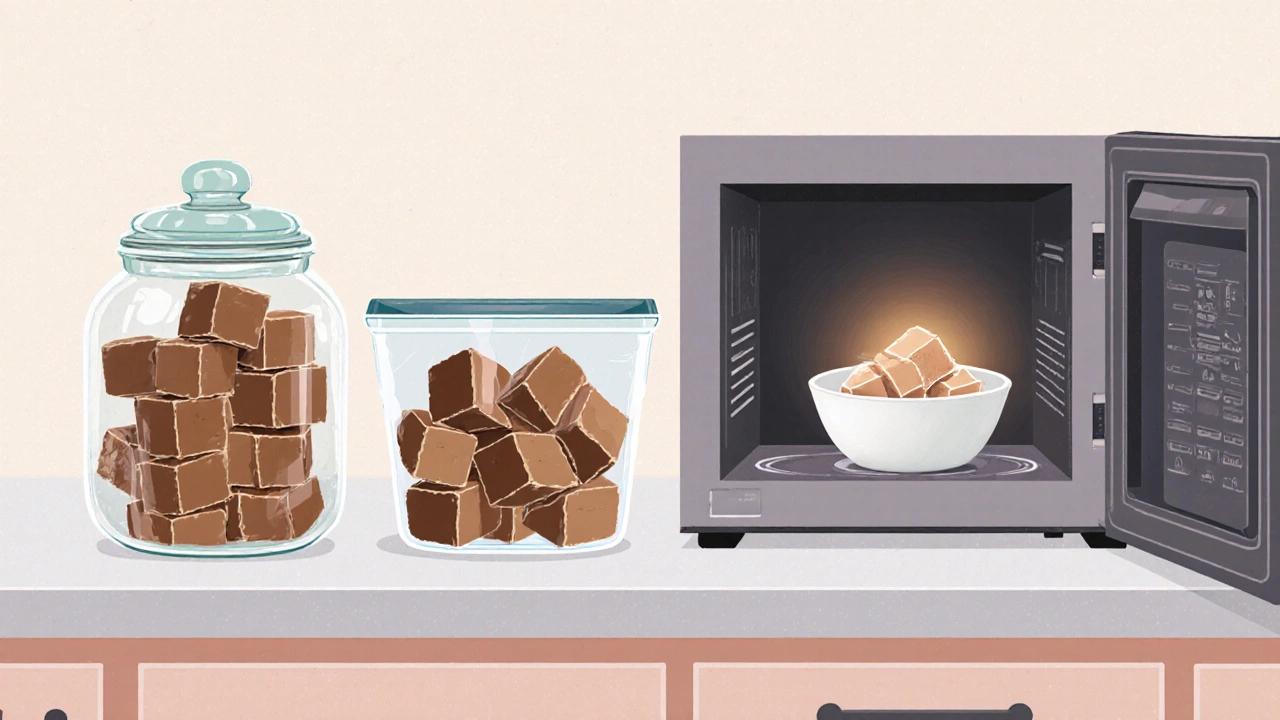
Fudge Texture Calculator
Enter values and click Calculate to see your fudge texture analysis.
Recommended storage method: Room temperature in airtight container
For optimal soft fudge, cook to the soft-ball stage: 236–240°F (113–115°C).
Ever taken a bite of homemade fudge only to find it rock‑hard? You’re not alone. The good news is that a few science‑backed tricks can keep fudge soft, creamy, and perfectly chewy for weeks.
Why Fudge Can Harden
When you heat sugar, butter, and chocolate together, you create a supersaturated syrup. As the mixture cools, sugar crystals begin to form. If those crystals grow too big, the fudge turns grainy and eventually hardens. Fudge is a confection made from a precise balance of sugar, fat, and liquid that sets into a dense but tender candy. Temperature, agitation, and the types of sugars you use are the three levers that decide whether the crystals stay tiny (soft fudge) or become large (hard fudge).
Key Ingredients that Influence Texture
- Butter provides fat that coats sugar crystals and slows their growth. Using real butter instead of margarine adds flavor and improves mouthfeel.
- Sugar is the primary sweetener; white granulated sugar crystallizes quickly, while brown sugar adds moisture.
- Corn syrup acts as an interferent, preventing sugar molecules from lining up into large crystals. A splash of corn syrup can be the difference between chewiness and brittleness.
- Chocolate contributes both flavor and additional fat (cocoa butter) that helps stabilize the crystal matrix. Dark chocolate with at least 60% cacao works best.
- Heavy cream adds dairy fat and water, lowering the final temperature at which the syrup sets. Replace with coconut cream for a dairy‑free version.
Balancing these ingredients is the first step toward soft fudge. Too much sugar or too little fat will inevitably lead to a hard final product.

Mastering the Cooking Temperature
The classic fudge recipe calls for heating the mixture to the "soft‑ball" stage, which is 236-240°F (113-115°C). Going any higher pushes the syrup into the "firm‑ball" or "hard‑ball" stages, where sugar crystals become too large.
- Use a reliable digital candy thermometer. Clip it to the side of a heavy saucepan and make sure the tip stays in the liquid, not the foam.
- Bring the mixture to a boil, then reduce the heat to maintain a steady simmer. Stir only enough to keep the bottom from scorching.
- When the thermometer reads 236°F, immediately remove the pot from the heat.
- Allow the fudge to cool to about 110°F (43°C) before beating. This cooling window is crucial; beating too early locks in large crystals, beating too late gives them a chance to grow.
Temperature control is the single most reliable way to keep fudge soft. Even a 2‑degree overshoot can shift the texture dramatically.
The Role of Fat and Sugar Ratios
Think of fat as the “lubricant” that keeps sugar crystals from sticking together. A simple rule of thumb is a 1:2:1 ratio of butter:sugar:liquid (cream or milk). For example, 1cup butter, 2cups sugar, and 1cup cream yields a smooth, pliable fudge.
If you like a richer treat, add an extra tablespoon of butter per cup of sugar. Just remember that each extra gram of butter raises the melting point slightly, so you may need to pull the fudge off the heat a degree or two earlier.
How to Store Fudge for Long‑Lasting Softness
Once you’ve nailed the perfect texture, storage becomes the next challenge. Moisture loss or temperature swings can cause fudge to dry out or harden.
| Method | Temperature Range | Resulting Texture | Shelf Life |
|---|---|---|---|
| Room‑temperature airtight container | 68‑72°F (20‑22°C) | Soft, slightly chewy | 1‑2 weeks |
| Refrigerated airtight container | 35‑40°F (2‑4°C) | Firm but still cuttable | 3‑4 weeks |
| Freezer (wrapped in parchment + foil) | 0°F (‑18°C) | Harder texture; can be thawed for softness | 2‑3 months |
For the softest result, keep fudge at room temperature in a sealed container. Adding a small piece of parchment paper on top before sealing helps retain moisture.

Quick Fixes for Already Hardened Fudge
If your fudge turned rock‑solid overnight, don’t throw it out. A gentle reheating can restore chewiness.
- Place the fudge in a microwave‑safe bowl.
- Heat on low (30% power) for 10‑15 seconds, then stir.
- Repeat in 10‑second bursts, stirring each time, until the fudge is soft enough to spread.
- Spread the softened fudge onto a parchment sheet, let it cool, then cut into squares.
Alternatively, melt the hard fudge with a splash of milk or cream over a double boiler, then pour into a new pan and beat again. The added liquid re‑introduces moisture, preventing future hardening.
Common Mistakes and How to Avoid Them
- Skipping the thermometer. Visual cues (like the soft‑ball stage) are unreliable; a thermometer removes guesswork.
- Over‑stirring after the boil. Once you remove the pot from heat, only brief, vigorous beating is needed to create tiny crystals.
- Storing in a non‑airtight container. Exposure to air accelerates moisture loss, making fudge dry and hard.
- Using low‑fat chocolate. Cocoa butter acts like butter in the crystal matrix. Choose chocolate with at least 30% cocoa butter.
- Adding too much corn syrup. While it prevents crystallization, excess makes fudge overly soft and gummy.
Correcting these habits makes a noticeable difference the first time you make fudge and saves you countless batches of disappointment.
Frequently Asked Questions
Can I make soft fudge without corn syrup?
Yes. Replace corn syrup with an equal amount of honey or golden syrup. Both act as interferents and keep crystals small, though the flavor profile will shift slightly.
Why does refrigeration sometimes make fudge harder?
Cold temperatures cause fats to solidify faster, firming the candy. If you prefer a softer bite, keep fudge at room temperature and only refrigerate if you need a longer shelf life.
Should I add vanilla extract before or after beating?
Add vanilla (or any flavoring) just before you start beating. This ensures the flavor is evenly distributed without evaporating during the final boil.
What humidity level is ideal for making fudge?
A moderate humidity of 45‑55% is ideal. Very dry air can cause rapid moisture loss, leading to hardening, while overly humid conditions may make the fudge too soft.
Can I freeze fudge and still keep it soft after thawing?
Yes. Freeze in an airtight wrapper, then thaw in the refrigerator for several hours. Once at room temperature, give it a quick stir to restore the creamy texture.